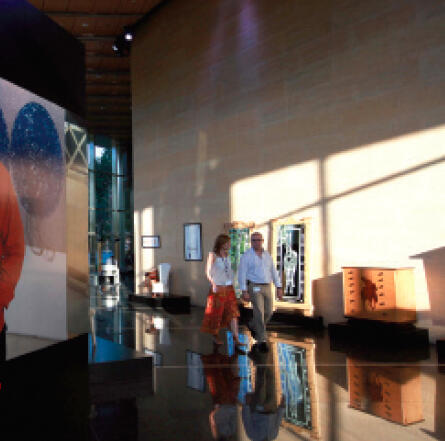Luis F. Benedit
Fundación YPF, Buenos Aires
Luis F. Benedit (Buenos Aires, 1937-2011) was surprised by death while he was preparing the exhibition “Luis Benedit. Designer,” which was recently inaugurated in the framework of YPF Foundation’s “Art in the Tower” program.

An artist, architect and designer, Benedit even studied landscape design in Rome in 1967, thanks to a scholarship granted by the Italian government. From the beginning of his career he developed the ability to contribute a new dimension to nature, science, utensils of everyday use, the countryside and its tools, national heroes, indigenous iconography, and Patagonian myths and heroes.
Furniture and objects designed by the artist grace the large space created by César Pelli at YPF’s corporate building. Benedit’s demise caused a temporary interruption of the project on which the artist had embarked with great enthusiasm. As a tribute to him, the preliminary sketches, drawings and notes were recovered and the original idea was resumed: to show Benedit’s facet as a designer.
Besides producing exquisite designs using noble materials, as for example a desk crafted from Italian oak or a chest of drawers made of ash tree wood with silver legs, the artist also worked with recycled material. Examples of this are the chair made of (sanded down) horse bones or the lamp made from an armadillo shell and cane, which certainly works and very well, by the way. The ensemble of carved mirrors, floor lamps, Art Deco inspired armchairs and tables, funny chairs and even a series of refined versions of barbecue knives, is completed by a showcase exhibiting Benedit’s notebooks and a video featuring an extensive interview describing his artistic trajectory, which began in 1961.
Over the decades, he had dozens of exhibitions in his native country, and he also showed at the New York MoMA and the Centre Pompidou in Paris. His paintings, sculptures, installations, watercolors, drawings and objects also showed their versatility when it came to working with the most dissimilar supports which, as part of his explorations of the relationships between nature and culture, included animals and plants. He represented Argentina in the 1970 Venice Biennial; on that occasion he presented the installation Biotrón, in which he displayed 4,000 live bees, placed in an artificial device made of transparent plastic, aluminum, and wood, and containing lamps and flowers, and which could choose between living in the mentioned artificial environment that imitated nature or in nature itself (which they could access through an opening in this habitat). Around 1980, Benedit began to focus on the countryside theme, but he always avoided nostalgia and folklore, offering commentaries on the present in his alluring works of impeccable facture. His constant search for a national identity was probably never strictly political.
“I want to produce some visual artifacts that may be described as for non-specific use,” he pointed out in 1999, when he presented some of these unique pieces at Ruth Benzacar Gallery. “I do not make any distinctions between architecture, painting and design, a term that is becoming increasingly important. Looking at a Ferrari and a Lucio Fontana, I consider them the same, but I choose the Ferrari,” he said somewhat humorously.






